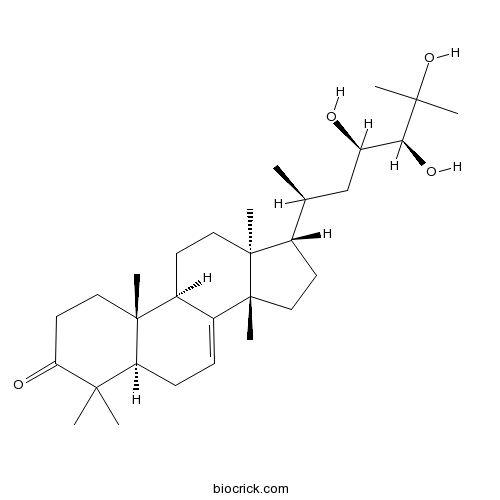Piscidinol ACAS# 100198-09-2 |

Quality Control & MSDS
3D structure
Package In Stock
Number of papers citing our products

| Cas No. | 100198-09-2 | SDF | Download SDF |
| PubChem ID | 12004524 | Appearance | Powder |
| Formula | C30H50O4 | M.Wt | 474.7 |
| Type of Compound | Triterpenoids | Storage | Desiccate at -20°C |
| Solubility | Soluble in Chloroform,Dichloromethane,Ethyl Acetate,DMSO,Acetone,etc. | ||
| Chemical Name | (5R,9R,10R,13S,14S,17S)-4,4,10,13,14-pentamethyl-17-[(2S,4R,5S)-4,5,6-trihydroxy-6-methylheptan-2-yl]-1,2,5,6,9,11,12,15,16,17-decahydrocyclopenta[a]phenanthren-3-one | ||
| SMILES | CC(CC(C(C(C)(C)O)O)O)C1CCC2(C1(CCC3C2=CCC4C3(CCC(=O)C4(C)C)C)C)C | ||
| Standard InChIKey | DCGUKHULKAAOPB-QBLSGNHRSA-N | ||
| Standard InChI | InChI=1S/C30H50O4/c1-18(17-22(31)25(33)27(4,5)34)19-11-15-30(8)21-9-10-23-26(2,3)24(32)13-14-28(23,6)20(21)12-16-29(19,30)7/h9,18-20,22-23,25,31,33-34H,10-17H2,1-8H3/t18-,19-,20-,22+,23-,25-,28+,29-,30+/m0/s1 | ||
| General tips | For obtaining a higher solubility , please warm the tube at 37 ℃ and shake it in the ultrasonic bath for a while.Stock solution can be stored below -20℃ for several months. We recommend that you prepare and use the solution on the same day. However, if the test schedule requires, the stock solutions can be prepared in advance, and the stock solution must be sealed and stored below -20℃. In general, the stock solution can be kept for several months. Before use, we recommend that you leave the vial at room temperature for at least an hour before opening it. |
||
| About Packaging | 1. The packaging of the product may be reversed during transportation, cause the high purity compounds to adhere to the neck or cap of the vial.Take the vail out of its packaging and shake gently until the compounds fall to the bottom of the vial. 2. For liquid products, please centrifuge at 500xg to gather the liquid to the bottom of the vial. 3. Try to avoid loss or contamination during the experiment. |
||
| Shipping Condition | Packaging according to customer requirements(5mg, 10mg, 20mg and more). Ship via FedEx, DHL, UPS, EMS or other couriers with RT, or blue ice upon request. | ||
| Description | 1. Piscidinol A is toxic against the 4T1 and HEp2 cancer cell lines, the IC50 of 8.0 ± 0.03 and 8.4 ± 0.01 uM, respectively. 2. Piscidinol A can inhibit NO production in mouse peritoneal macrophages with inhibitory ratios ranging from 39.8±7.7 to 68.2±4.5%. |
| Targets | NO |

Piscidinol A Dilution Calculator

Piscidinol A Molarity Calculator
| 1 mg | 5 mg | 10 mg | 20 mg | 25 mg | |
| 1 mM | 2.1066 mL | 10.533 mL | 21.0659 mL | 42.1319 mL | 52.6648 mL |
| 5 mM | 0.4213 mL | 2.1066 mL | 4.2132 mL | 8.4264 mL | 10.533 mL |
| 10 mM | 0.2107 mL | 1.0533 mL | 2.1066 mL | 4.2132 mL | 5.2665 mL |
| 50 mM | 0.0421 mL | 0.2107 mL | 0.4213 mL | 0.8426 mL | 1.0533 mL |
| 100 mM | 0.0211 mL | 0.1053 mL | 0.2107 mL | 0.4213 mL | 0.5266 mL |
| * Note: If you are in the process of experiment, it's necessary to make the dilution ratios of the samples. The dilution data above is only for reference. Normally, it's can get a better solubility within lower of Concentrations. | |||||

Calcutta University

University of Minnesota

University of Maryland School of Medicine

University of Illinois at Chicago

The Ohio State University

University of Zurich

Harvard University

Colorado State University

Auburn University

Yale University

Worcester Polytechnic Institute

Washington State University

Stanford University

University of Leipzig

Universidade da Beira Interior

The Institute of Cancer Research

Heidelberg University

University of Amsterdam

University of Auckland

TsingHua University

The University of Michigan

Miami University

DRURY University

Jilin University

Fudan University

Wuhan University

Sun Yat-sen University

Universite de Paris

Deemed University

Auckland University

The University of Tokyo

Korea University
- MK-8033
Catalog No.:BCC1768
CAS No.:1001917-37-8
- INH6
Catalog No.:BCC5455
CAS No.:1001753-24-7
- SRT1720 HCl
Catalog No.:BCC2222
CAS No.:1001645-58-4
- BV6
Catalog No.:BCC5372
CAS No.:1001600-56-1
- 1,4,5,6-Tetrahydroxy-7-prenylxanthone
Catalog No.:BCN1642
CAS No.:1001424-68-5
- PDK1 inhibitor
Catalog No.:BCC1843
CAS No.:1001409-50-2
- VUF 8430 dihydrobromide
Catalog No.:BCC7384
CAS No.:100130-32-3
- GDC-0068 (RG7440)
Catalog No.:BCC1271
CAS No.:1001264-89-6
- GnRH Associated Peptide (GAP) (1-13), human
Catalog No.:BCC1013
CAS No.:100111-07-7
- Chloramultilide D
Catalog No.:BCN7102
CAS No.:1000995-49-2
- Chloramultilide C
Catalog No.:BCN6618
CAS No.:1000995-48-1
- Chloramultilide B
Catalog No.:BCN6613
CAS No.:1000995-47-0
- 2,3-dihydroxy-3-(4-hydroxyphenyl)propanoic acid
Catalog No.:BCN1641
CAS No.:100201-57-8
- 5,5'-Dimethoxysecoisolariciresinol
Catalog No.:BCN7941
CAS No.:1002106-91-3
- Camstatin
Catalog No.:BCC5690
CAS No.:1002295-95-5
- AMG-208
Catalog No.:BCC1054
CAS No.:1002304-34-8
- Picrasidine I
Catalog No.:BCN5819
CAS No.:100234-59-1
- Picrasidine J
Catalog No.:BCN5820
CAS No.:100234-62-6
- TZ9
Catalog No.:BCC5547
CAS No.:1002789-86-7
- Irinotecan hydrochloride
Catalog No.:BCN2949
CAS No.:100286-90-6
- Apiopaeonoside
Catalog No.:BCN2801
CAS No.:100291-86-9
- Pemirolast potassium
Catalog No.:BCC4532
CAS No.:100299-08-9
- L(+)-Rhamnose monohydrate
Catalog No.:BCN8368
CAS No.:10030-85-0
- Curcumenone
Catalog No.:BCN3008
CAS No.:100347-96-4
Tirucallane triterpenoids from the stems of Brucea mollis.[Pubmed:23576355]
Chem Biodivers. 2013 Apr;10(4):695-702.
Three new tirucallane triterpenoids, brumollisols A-C (1-3, resp.), together with five known analogues, (23R,24S)-23,24,25-trihydroxytirucall-7-ene-3,6-dione (4), Piscidinol A (5), 24-epiPiscidinol A (6), 21alpha-methylmelianodiol (7), and 21beta-methylmelianodiol (8), were isolated from an EtOH extract of the stems of Brucea mollis. Their structures were elucidated by means of spectroscopic methods including 1D- and 2D-NMR techniques and mass spectrometry. In the in vitro assays, compound 6 exhibited significant cytotoxic activity against A549 and BGC-823 cancer cells with IC50 values of 1.16 and 3.01 muM, respectively. At a concentration of 10 muM, compounds 1-5, 7, and 8 were found to inhibit NO production in mouse peritoneal macrophages with inhibitory ratios ranging from 39.8+/-7.7 to 68.2+/-4.5%.


